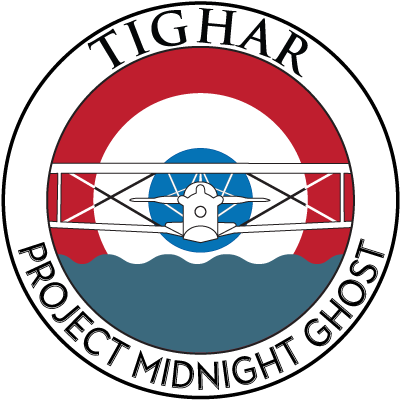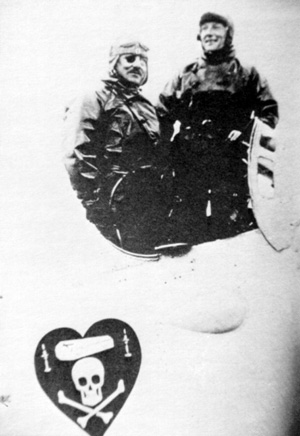
The International Group for Historic Aircraft Recovery
2366 Hickory Hill Road · Oxford, PA · 19363 · USA
610.467.1937 · info@tighar.org
 |
The International Group for Historic Aircraft Recovery |
|||||
 |
Enter the White Bird |  |
|
The October 26, 1969 issue of The Newfoundland Herald carried the banner headline “A KEY TO WORLD AVIATION HISTORY LIES BURIED NEAR PATRICK’S COVE.” An article written by Jack Fitzgerald revealed “secret” information disclosed in an exclusive interview with John McGrath, then living in Colinet but formerly of Patrick’s Cove. John said wreckage recovered from Big Gull Pond by James J. Doyle and Patrick Judge was identified as undercarriage of an airplane. McGrath believed the plane to be the White Bird, “a small blue and white aircraft” that “set out from France in 1921 with two pilots on board in the first attempted east-west crossing of the Atlantic.” Although wildly inaccurate in its details, this is the first documented instance of the plane in the pond being linked to the disappearance of l’Oiseau Blanc. Up to this time, knowledge of the plane in the pond appears to have been limited to the McGraths of Patrick’s Cove and Patsy Judge and his father-in-law James Joseph Doyle who lived in Gooseberry two and a half miles up the road. John McGrath was the older brother of Anthony McGrath who recovered a piece of the plane in 1940. In a 1992 interview, Anthony said his brother John had also collected a piece of the plane and, in a 1994 interview, John’s son Dermot said when he was a child (this would be around the same time the Herald article was published) his father would not let his children play with his “souvenir of the White Bird.” However, the 1969 article makes no mention of John McGrath having a piece of the plane. According to Fitzgerald’s article, John McGrath connected the plane in the pond with the White Bird because:
There is no evidence anything like that happened. May 9, 1927 was nether stormy nor foggy, but there are accounts of Sydney Cotton’s plane being heard over Patrick’s Cove during his search for the White Bird in June 1927. The strongest evidence that the plane in the pond might be the White Bird is the body of documented accounts that trace the aircraft’s path on the morning of May 9th down the Avalon Peninsula and across St. Mary’s Bay to within seven miles of the Gull Pond — but none of that is mentioned in Fitzgerald’s article. However flawed the information and reasoning behind the headline, the Herald article launched a new era in the Gull Pond saga. Suddenly the plane in the pond was no longer a local curiosity known only to a handful of people but a “KEY TO WORLD AVIATION HISTORY.” Fitzgerald wrote, “If McGrath’s theory is right then the first east west crossing of the Atlantic was made by two French pilots Nungesser and Coli whose skeletons should be located at the bottom of Gull Pond.” (Yes and no. If they reached Newfoundland it would be the first east to west crossing, but the Fédération Aéronautique Internationale does not recognize as an official record a flight that ends with the destruction of the aircraft and the death of the crew.)[8] The following summer, in July or August of 1970, the Cape Shore parish priest, Father Charles McCarthy, 35, had Patrick McGrath, then 47, show him where he had seen wreckage many years before. Wearing a wet suit, mask and snorkel, McCarthy searched parts of the pond. On the rocky bottom in about one foot of water near the island, McCarthy found two metal bands connected with a six inch threaded bolt and nut. The ends of the bands were jagged as if broken by force, not corroded away. He thought it looked like something that might have been used to secure a tank or some heavy object. The piece was lost after McCarthy left the priesthood the next year and moved to California.[9] |
||
| ||
| The Phantom Letter | ||
|
The revelation that the plane in the pond might be of great historical significance prompted competing claims about who had been the first to see the wreckage. Nicholas McGrath told a dentist from St. John’s that he had heard explosions in May 1927 and saw metal under the ice the following winter. Anthony McGrath claimed he had been the first, twisting a piece out of the ice in 1940. Patsy Judge defended his claim to fame by saying he had recovered a piece of the plane in 1932, had later sent it to England, and had received a letter in return confirming the piece was from the undercarriage of either the Bluebird or the White Bird. Such a letter would, of course, be of tremendous significance. According to a 1994 interview with Patsy’s son James:
In 1973, the story reached Robert Parker, producer of the Canadian Broadcasting Corporation series “Up Canada” in Toronto. Seeking to track down a copy of the letter, Parker contacted Ralph Martin in England. Martin confirmed he had received a piece of metal from Judge and had given it to someone at an AVRO Aircraft factory near his home, but he had no further information. In a May 24, 1974 letter to Ralph Martin, Parker thanked him for his help and said he had spoken with the Managing Director of Hawker-Siddeley which had acquired AVRO in 1963. The executive promised to search the company’s back files and make inquiries of senior employees but cautioned that a fire several years ago had destroyed a number of old records. TIGHAR has since confirmed that an October 3, 1959 fire at the Chadderton AVRO plant near Martin’s home destroyed large sections of the production and office facilities. Unable to confirm Judge’s claim about the letter, Parker dropped his investigation. Patsy Judge was incensed and, on June 18, 1974, sent a hand-written letter to Ralph Martin (spelling as in the original).
On July 4, 1974, Martin replied:
A TIGHAR researcher’s notes from July 6, 1993 telephone interview with Ralph Martin, then 88, provides more information.
While there is no doubt that Patsy Judge gave a piece of metal to Ralph Martin who then passed it on to AVRO, the letter Patsy said he received in return makes no sense.
| ||
| All of the interviews and documents cited below are available at the Resources link below. |
| Notes | |
| 8 | Newfoundland Herald, Vol. 24, 10/26/1969; Ric Gillespie interview with Anthony McGrath 9/18/1992; Robin McGrath interview with Dermot McGrath 7/1994. |
| 9 | Charles McCarthy: Ric Gillespie interview with Charles McCarthy 11/5 1993; Note and pencil drawing sent by Charles McCathy to Ric Gillespie 12/1/93; Ric Gillespie interview with Patrick McGrath 9/18/1992; Ric Gillespie interview with Hubert McGrath 9/17/92. |
| 10 | Phantom Letter: Florence Coffey interview with James Judge 7/17/1994; Robert Parker letter to Ralph Martin 5/24/1974; Patrick Judge letter to Ralph Martin 6/18 1974; Ralph Martin letter to Patrick Judge 7/4/1974; Jay Veith interview with Ralph Martin 7/6/1993; Levasseur Album Photographique, Avion marin. |
| Click HERE for the final section of this paper. |
| Evidence | Expeditions | Resources | Plans |
|
|
||||||||||
|